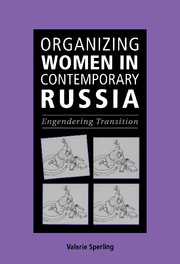Book contents
- Frontmatter
- Contents
- List of tables
- Acknowledgments
- Note on transliteration
- Map
- Introduction
- 1 Russian women's movement groups and activists
- 2 Analyzing social movements
- 3 Feminism, femininity, and sexism: socio-cultural opportunities and obstacles to women's movement organizing
- 4 “Democracy without women is not democracy!”: political opportunities and obstacles to women's movement organizing
- 5 “Unemployment has a woman's face…”: economic opportunities and obstacles to women's movement organizing
- 6 Remembrance of things past: the impact of political history on women's movement organizing
- 7 International influences on the Russian women's movement
- Conclusion
- Appendix
- Selected bibliography
- Index
5 - “Unemployment has a woman's face…”: economic opportunities and obstacles to women's movement organizing
Published online by Cambridge University Press: 22 September 2009
- Frontmatter
- Contents
- List of tables
- Acknowledgments
- Note on transliteration
- Map
- Introduction
- 1 Russian women's movement groups and activists
- 2 Analyzing social movements
- 3 Feminism, femininity, and sexism: socio-cultural opportunities and obstacles to women's movement organizing
- 4 “Democracy without women is not democracy!”: political opportunities and obstacles to women's movement organizing
- 5 “Unemployment has a woman's face…”: economic opportunities and obstacles to women's movement organizing
- 6 Remembrance of things past: the impact of political history on women's movement organizing
- 7 International influences on the Russian women's movement
- Conclusion
- Appendix
- Selected bibliography
- Index
Summary
Unemployment has a woman's face, but power has a man's.
The changing political opportunity structure in Russia at the end of the 1980s, and continuing into the 1990s, allowed for the emergence of numerous women's organizations, ranging from advocacy groups, consciousness-raising groups, and women's research centers, to support groups for women in various professions. Many of these groups had a politicized orientation. They recognized that women's second-class status in Russia was socially determined, and tried to raise awareness of that fact, holding various seminars, meetings, and conferences; publishing critical articles in the press; initiating women's publications; making contact with state officials; and so on.
Meanwhile, as the 1990s began, new women's groups developed, intending to ameliorate the effects on women of Russia's economic crisis and devastating cuts in social services. The activities of these organizations spanned a broad spectrum, from charity events to women's job-training programs, from occupational health and safety inspections in factories to support for single mothers and women attempting to enter the business world.
But the economic transition did more than spur the creation of new women's groups. It also set a backdrop of hardship against which all independent organizations had to struggle to survive. In short, Russia's economic transition created both opportunities and obstacles for the emerging women's movement and its development.
- Type
- Chapter
- Information
- Organizing Women in Contemporary RussiaEngendering Transition, pp. 146 - 178Publisher: Cambridge University PressPrint publication year: 1999



